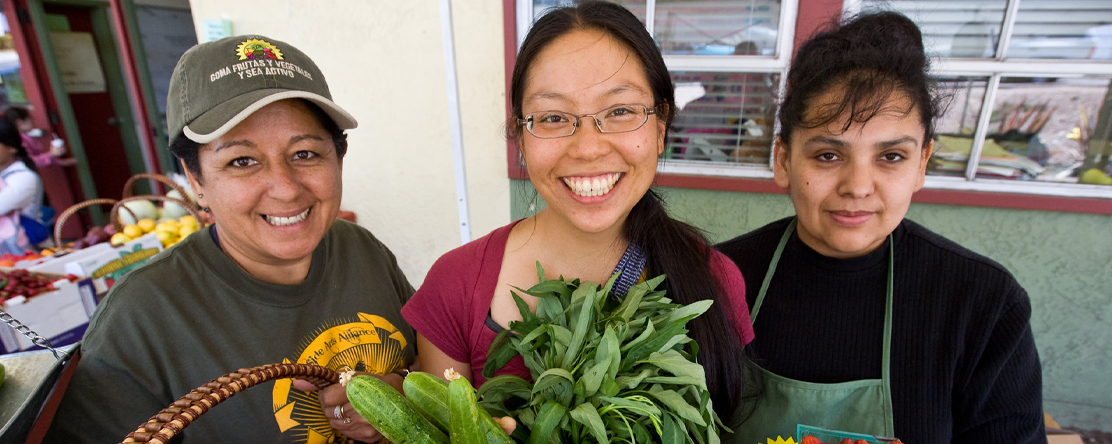
Update
Perspectives on Food Justice in 2017
-
Focus Areas
Capacity Building & Leadership -
Issues
Nutrition & Food Security -
Programs
CA4Health

Last year, PHI’s CA4Health initiated a number of processes to determine the top issue areas of interest for members of our Community of Practice. When it comes to public health issues, Food Justice was an overwhelming priority for action and shared learning. As we kick off 2017, we wanted to hear from some of our leaders in this area of work to gather their perspectives on Food Justice, social movements, and the year ahead.
Meet the leaders:

- Janaki Jagannath, Coordinator with the Community Alliance for Agroecology (Fresno, CA)
- Michael Dimock, President with PHI’s Roots of Change (Oakland, CA)
- Elle Mari, M.Sc, Director of Urban Food Environments at the Center for Community Health, University of California San Diego (San Diego, CA)
- Planting Justice (Oakland, CA)
What does Food Justice mean to you and your work?
JJ: In the Central Valley and in rural places in CA, Food Justice is the first layer in the ocean of different issues that communities of color deal with, particularly farm worker communities. Food Security is defined as access to food for all people and populations and also being able to know where that next meal is coming from, but as we take this concept a little further into rural populations that have been denied participation in civic spaces, access to clear air and clean water, Food Justice really means access to participation in the imagining of your community. Taken a bit further, we get into switching from Food Justice to Food Sovereignty—including access to decision-making around natural resources. When you look at it this way, we’ve never really had Food Justice for rural areas, for those residents living in remote communities that don’t have access to the fresh produce that they spend their days picking in CA fields, for example. Food Justice is the first step to civic participation and natural resource decisionmaking.
PJ: At Planting Justice, we work for Food Justice because we know that if we change the food system, we change everything. The food system is one of the largest pieces of the global economy, and is a fulcrum for every justice issue, from the environment to labor to immigration to health. To us, Food Justice means transforming the food system in a way that democratizes access to affordable, nutritious food, expands job opportunities for historically disenfranchised people, and ensures environmental sustainability. We believe that nutritious food is a human right, not a commodity, luxury or status symbol. We believe that everyday people can & should actively participate in the food system as more than just passive consumers, because we know that growing & cooking our own food is empowering, creative, healing, life-affirming labor that has been seriously undervalued in our post-industrial society.
MD: Food Justice is a tool to overcome the social determinants of health. Food Justice is a means to end the historical systems of structural oppression that have kept people of color and low income white folk from accessing and affording healthy food and receiving living wages for their labor in the agricultural and food sector. Food Justice is achieved by helping isolated or underserved communities to build new structures that end the oppression and allow access, enable purchase and render higher wages. These structures might include community-based/operated food projects (urban gardens and farms, community kitchens or processing and distribution capacity) or enterprises that provide access and generate jobs with livable wages. It may also include subsidies such as SNAP, WIC, SSI and nutrition incentives that make healthy food affordable or policy changes that end redlining and other obstacles to capital, both human and financial, it might include humane and intelligent immigration laws that impact the millions of undocumented that work in the food and farm sector and are greatly disadvantaged and vulnerable due to their immigration status. Finally, it may also include nutrition education of children and families and improvements in school food in order to support the learning and capacity development of disadvantage children.
EM: Food Justice to me means consciously working in a space and within a framework that acknowledges and addresses institutional and historical oppressions in our food system and builds community-owned solutions towards systemic positive change. My work is situated on improving the urban food environment, primarily via small neighborhood and ethnic food markets. These are often places of opportunity, existing strength, and critical community connectivity in under-resourced neighborhoods.
What makes working in the area of Food Justice unique in 2017?
JJ: What makes it unique is that it’s a movement that sets itself apart from dominant environmental or even slow food movements that have been dominated by urban, well-off populations. Food Justice is an explicit connection of the inequities in the food and farming systems to histories of oppression among people of color. Thereby it has been lead by people who feel the impacts of food insecurity. So here in 2017, the political context that is allowing for greater advancement is allowing for a linking of urban and rural communities around environment and climate and social justice—Food Justice has a large part to play in that and hopefully we will see it flourish as civil society looks into the impacts on rural populations, the history of segregation and political disenfranchisement. Food Justice can be a good link across our regions and around various campaigns around equity; climate, environmental, economic and other.
PJ: 2017 is an exciting—albeit sometimes terrifying—time to be alive and working for justice in the United States. One of our early mottos at Planting Justice is, “Compost the Empire”—and we believe that the empire is indeed beginning to die. We want to seize this opportunity to work with everyday folks to take the food system back from corporations that exploit our health, our communities, our labor, and our planet—before it’s too late.
MD: On the challenges side, the new Executive Branch and Republican-controlled Congress could mean significant changes to federal policies that have heretofore had a mitigating effect on the systems of structural oppression. The policies that threaten to undermine the efforts to increase Food Justice include the Nutrition Title of the Farm Bill and that includes the new food insecurity nutrition incentive program, community food security projects; new, beginning and underserved farmer programs; HUD programs dedicated to food enterprise financing in low income communities; child nutrition; immigration enforcement and labor policies related to E-verify and agricultural labor practices. On the advantages side, there are many food and social justice NGOs and CBOs that are deeply energized by the political shift at the federal level. In states where progressive legislatures and executives are in office, new opportunities for policy innovations in support of Food Justice may be possible.
EM: 2017 is a year of great opportunity for myself and my team, however like I’m sure most of my colleagues and friends feel, it’s also a year of extreme uncertainty. In my view, and perhaps also in the view of many of my colleagues (both activists and academics in the field), Food Justice is a framework for change that gives attention to the following: oppressions (race, class, gender), community engagement, economic justice for the disenfranchised, cultural relevancy, environmental sustainability, and the notion that we all have the right to healthy affordable food in order to thrive. These values are currently being challenged at a societal level. Working towards Food Justice is imperative now more than ever in order to demand new policies/programs and protect existing policies that support fairness in our food system. I’m incredibly grateful for the work I get to do with small market owners, neighborhood residents, youth, and urban growers because collectively this constellation of folks represent the emergence of a new localized nexus of power to build healthy sustainable change.
From your perspective, how does Food Justice offer broad opportunities for traditional health partners to engage in equity movements that advocate for economic and social justice as well?
JJ: All of us who are leaders of color within this movement often think about how to make these connections more explicit and how to be more effective organizers around these issues. I think we have to go back to the beginning of agriculture in the US to deeply understand our location in this movement today. Access to food, withholding it and the means of its production, has been a strategy to control people for centuries. Here in the U.S. that began with settler agriculture and later with the introduction of chattel slavery in North America. Food has always been a tool to subjugate the “lesser” in the United States. As much as we in the progressive movement would like to think that these power dynamics are receding, we see these stratifications have continued and play a role, and health outcomes haven’t changed very much in recent years. Access to food and access to health are not necessarily challenges that are being overcome by communities of color, particularly in dense urban areas and across rural America. We have to look at agriculture—the deep linkages between who owns the land, who has access to being a farmer and what those people look like; and those who works in the fields and what those people look like. Accepting this boldly is foundational to advance a holistic movement for Public Health, food access, safety and Food Justice. We must bravely, together, address these challenges that are at the core of our history—and recognize that these movements are not separate. They tie back to the history of the United States and the settling of agriculture on this continent. Food Justice and Black Lives Matter, Food Justice and rights for immigrants regardless of religion, Food Justice and the protection of trans lives, Food Justice and climate justice—these are all linked. It is our task to remind and remember, all of us, the importance of making these linkages, and in the wellbeing of our people—one is not without the other.
PJ: Change the food system, change everything. The dominant food system currently relies on the extreme exploitation of (often undocumented) labor to grow, process, package, and prepare food for our consumption. The dominant food system currently treats food as a commodity. Companies are encouraged to provide the cheapest and most addictive foods, no matter the cost to workers, the health of consumers, and the environment. When we take the food system back by growing our own food, we stand up for the rights and dignity of all people and empower ourselves to provide for our own communities’ needs without relying on a system that is so harmful to so many people.
MD: Given the state of motivation I mentioned in the previous answer, traditional health partners could use their resources (community benefit funds, philanthropic funds, technical assets) to assist CBOs and NGOs to mobilize, organize and advocate for the types of policies that increase Food Justice and social equity and thereby lower the negative impacts of poor nutrition, oppression and poverty on human health. I would caution that the Food Justice sector is under-resourced as it is and our goal is to increase the flow of capital (human and financial) into the Food Justice sector. I would bet that racial justice and immigrant right nonprofit sectors are more well-funded than Food Justice.
EM: A Food Justice orientation to doing community/public health work offers advocates an opportunity to get at the root of things. Educating people on healthy lifestyle changes is important. Co-creating a built environment that provides easy access to a healthy lifestyle is also important. But perhaps most important, in my view, is creating opportunities for more community-level power to define problems and solutions from within. Food and health work writ large requires multidisciplinary action. For example, before we can talk about blood pressure, we might have to talk about unemployment rates and understand the connection between the two.
What do you see as the role of community leadership in this work?
JJ: Community voices and leaders have always been the ones carrying these dialogues forward. Sometimes we can rely on political and educational institutions to work in partnership with us, but when it comes to access to food for all, this work has been led by grassroots organizations and women in particular – they play a critical role and are to be honored especially by those who do not approach such work from an experiential space. While some may use data or logical analysis to approach Food Justice work, or theoretical reasoning, we should seek to privilege those who speak from the experiential impacts of inequity. I would like to see people who come into the movement as organizers have opportunities to grow into leadership, and those who work in institutions like the legislature provide more opportunities for professional development for grassroots members to participate more professionally with Public Health at agency and political levels to build power.
PJ: We’ve been intentional about hiring through our community education programs, growing and harvesting leadership directly from the communities we serve. We partner with the Insight Garden Program to provide job and life skills training at San Quentin State Prison. Graduates of that program who parole to Alameda or Contra Costa county can come work for us at a $17.50/hr starting wage immediately after their release. Over the past 6 years, our re-entry program has maintained a 0% recidivism (return to prison) rate, and some of our strongest leaders are formerly incarcerated staff members who are living proof that radical transformation is possible, no matter what mistakes a person has made in life. Another great example of organic community leadership at Planting Justice is Salvador Mateo, who we hired right out of our garden program at Fremont High School when he was 17 years old (shortly after his parents were deported as undocumented immigrants). 6 years later, Sal manages our Transform Your Yard landscaping team and has helped build hundreds of gardens throughout the Bay Area, empowering people to grow their own food.
MD: Without community leadership the initiatives to improve Food Justice will fail because they will not be authentic or legitimate, which means they will not be embraced by communities needing to be served. For example, a health impact fee imposed on sugary beverages at the state level in order to fund chronic disease prevention through improved nutrition, education and clinical intervention will not be achieved unless communities push their elected representatives support such a policy. Community leadership is essential. Community leadership was also essential creation of the Market Match nutrition incentive program in California in 2009-10. The program was designed by the CBOs that are now implementing that program.
EM: See above.
What do you see as the most critical points of action in the year ahead to advance and support Food Justice issues?
JJ: I think that at this current space given the outcome of the election and the current administration, I know that a lot of people are talking about ways to bring campaigns to the local level and capitalize on power-building on municipal and county levels. I think we are at the place where we have a certain amount of opportunity, even though Federal government seems to be fast-tracking a plan to reverse a lot of positive outcomes for communities of color that have been achieved over the past years, city ordinances, supporting local businesses, and other local initiatives can have multiple effects. Many efforts to simultaneously address opportunities to support local people and Food Justice are important, such as with improving opportunities for mobile vending, and supporting small scale farmers who are growing for our local markets and finding ways to advance their ability to sell more. It’s important that the Food Justice movement keep working to protect our residents but also think creatively about coming back to local communities to make connections at the family and neighborhood levels that are critical to protect the wins we have had so far, and to fix the glaring attacks on the most vulnerable through the Executive Orders from the new administration.
PJ: In the year ahead, we are focused on 3 priorities:
- Building more gardens for more people. We want to equip as many people as possible with the skills, knowledge and resources they need to grow the majority of their own produce in their backyard and/or neighborhood. Growing our own food locally means better tasting, more nutritious food that does not rely on exploited labor or wasteful use of fossil fuels.
- Helping disenfranchised communities get access to land which they can use to feed and house themselves. The rapid displacement of poor and working-class people of color from the Bay Area is of grave concern to us, and we want to work to stop the privatization of land so that communities can have what they need to survive and thrive.
- Promoting holistic re-entry programs to eliminate recidivism. In California, 7 out of 10 people released from prison end up back inside in less than one year. Meanwhile, our (very low-budget) reentry program has maintained a 0% recidivism rate for the last 6 years. We believe we’ve proved that our holistic re-entry model—training and education inside the prison, a life-sustaining wage, peer support, access to healthcare, meaningful community-based work and opportunities to advance—works, and should be funded instead of funding the expansion of jails and prisons.
MD: Increased funding is essential as well as increased commitment to policy advocacy and intervention. We need a C4 and willingness to wade into the hardball politics required to shift the priorities of legislators.
EM: While also working to protect food entitlement programs like CalFresh and School Meals, I think it’s also key that we work on economic levers to make healthy food more affordable for low-income shoppers, make the business of growing food profitable for local small-scale growers, and continue to fund and test promising projects that help build wealth alongside health. For example, I’m currently in the planning stages of a new project called the Viva Produce Purchasing Cooperative that I hope to fund a feasibility study on. This is a fresh fruit and vegetable purchasing cooperative that creates an alternative, hyper-localized food distribution system for small grocery and mini markets in high priority neighborhoods in the City of San Diego such as City Heights, Southeastern San Diego, Barrio Logan, and Linda Vista—pairing them with community-based, primarily urban growers. Stay tuned!
Anything else you’d like to add? Final thoughts?
EM: Working from a strengths-based perspective is key for us. Sometimes it’s too easy to spot what’s broken, but can we uncover what’s already working and invest our resources in those community points of resilience and success?
More Updates
Work With Us
You change the world. We do the rest. Explore fiscal sponsorship at PHI.
Support Us
Together, we can accelerate our response to public health’s most critical issues.
Find Employment
Begin your career at the Public Health Institute.



